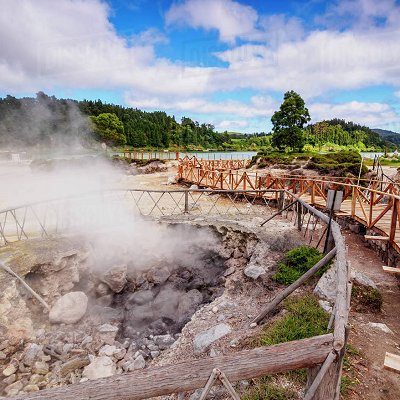
Like us on Facebook
PLACE NAMES




|
|
Furnas
|

|
|
Furnas is a civil parish in the municipality of Povoação on the island of São Miguel in the Portuguese Azores. The parish is one of the largest in the island and in the Azores. It is located east of Lagoa and Ponta Delgada, west of Povoação and southeast of Ribeira Grande.
Furnas is located in the easternmost of three active trachytic volcanoes on the island of São Miguel, in the historically active Volcanic Complex of Furnas. With a complicated 100,000 year history, the central caldera of the Furnas Volcano is a naturally explosive trachyte structure composed of two main calderas, that through formation, collapse and explosion have marked the natural history of the massif. The oldest caldera's escarpment cuts the lava structures of the neighbouring Volcanic Complex of Povoação to the north and northeast and southeast to valley of Ribeira Quente. The second caldera dates back 35000 years (the youngest caldera) and is geomorphologically identifiable by the 200 metre wall to the north and northwest. Within the caldera are numerous pumice cones and maars resulting from Plinian and Phreto-plinian eruptions from 5000 years.
Owing to the existence of a population of several thousand people living within and around its caldera it is considered one of the most dangerous volcanoes in archipelago. Throughout its history, volcanic activity at Furnas has been essentially explosive but eruptive styles have varied from mild effusive activity to at least two caldera-forming eruptions 30,000 and 12,000-10,000 years ago. It is considered very active, since ten sub-Plinian eruptions have occurred within the past 5,000 years, producing a total area of 0.9 kilometres square of fairly homogeneous trachytic magma. The first known historical eruption occurred in 1440, just after early settlers started populating the coasts of São Miguel. The latest eruption occurred after the settlement of the Azores archipelago in 1630 AD, and caused the deaths of 200 people. Eruptions of the Upper Furnas Group were mainly characterised by alternating episodes of magmatic and phreatomagmatic activity producing deposits of inter-bedded volcanic ash and lapilli that overlie the widespread main deposits from the adjacent Fogo volcano. At least three of these eruptions were accompanied by trachyte dome extrusions in the final phases of the eruption.
The western of the two calderas is partially filled by a crater lake, Lagoa das Furnas, at an elevation of 359 metres (1,178 ft) and populated by several fumaroles and mud pools are located at the northern part of the lake. In the central part of the village, springs and geysers are prevalent; thirty springs, each of differing temperatures and chemical compositions, including warm iron-rich streams and piped examples of mineral-rich warm and cold water. The geysers are situated in several basins rich in sodium bicarbonate, boron, fluorine and traces of carbon dioxide. The local inhabitants cook corn-type dishes in the geysers. The installations of hydrotherapy are in the park and were built in the 19th century.
 Feel free to Email me any additions or corrections Feel free to Email me any additions or corrections
LINKS AVAILABLE TO YOUR SITE
| | |





